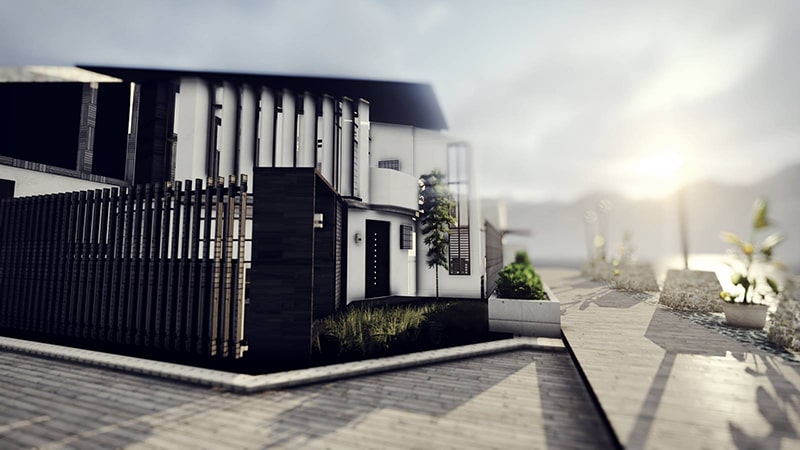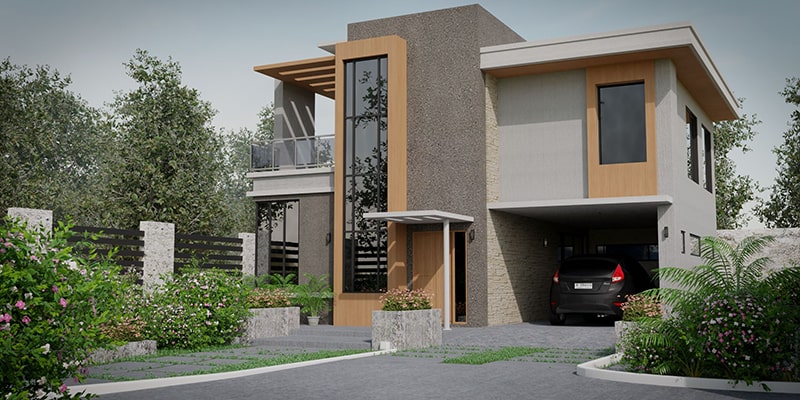3D architectural rendering is one of the great new advances in technology that can make or break a project. With architecture, landscape design, or real estate, having an accurate and dynamic 3D rendering service can be a truly impactful presentation tool and can act as a draw for potential clients. When 3D renderings are done right, they can change the game in a number of ways.
If you are an architect or have a real estate business, or something similar, you may be considering incorporating 3D architectural rendering into some of your customer proposals, marketing material, or somewhere else. Because this is such a dynamic and powerful tool, 3D renderings are great to incorporate, but they are also difficult and time-consuming.
The question is, if you’re going to do this, should you learn how to do it yourself and create your own designs in-house, or should you hire an outside freelance 3D modeler to create your 3D renderings? Let’s examine some of the pros and cons of creating these presentations in-house versus using an outside freelance resource for your renderings.
Pros for Doing Renderings In-House
1. Cost Control

If you are doing the renderings in-house, either by yourself or through someone on your team, you control the cost entirely. It’s budgeted in as part of your time or part of your team’s time, and there are no surprises.
This level of control over the cost allows you to properly manage the budget and adjust accordingly. Because of the scope of these types of projects, they can be very time-consuming and costly, even for professional drafting services. So, being able to control the budget more precisely is extremely useful. These costs are also very straightforward and upfront. There are no additional fees that need to be considered.
2. Control Over the Process
Another benefit of doing the 3D rendering work in-house is that you have intimate control over the process. Not only do you have control over the budget, but you can see the rendering take shape and control it as it changes.
Such visibility into the process allows you to make adjustments, redesign the work as needed, and restructure your plan throughout the creative process. Not only does this give you control internally, but it allows you to adjust the timeline and discuss the progress with a customer.
For instance, if you are creating a landscape plan for a customer, you can show them the progress immediately and let them see the half-complete design if they request it, instead of waiting for a finished copy or section at a tollgate review.
Visibility into the process is invaluable and it allows you to be more open with a customer as well as with your employees so that you can tweak the process, timeline, and budget accordingly.
3. Creating an Additional Skill Set
You can’t overstate the value of learning a new skill. 3D rendering and architectural designers are extremely lucrative fields, so adding those skills to your assets can vastly improve your marketability.
If you learn it yourself, you can market that as your own personal skill and do any rendering you need personally, and if you are incorporating it into your team, you can use it as a selling point for your organization. Either way, it is an extremely valuable skill set and it will improve sales to be able to market the fact that you can create architectural renderings and do 3D designs.
When you have learned how to perform this work on your own, the next time you need something similar created, you won’t have to reach outside of your organization. You will be able to do it all in-house. This simplifies the process and ensures that you’ll always have the availability and capability of creating 3D architectural renderings for your clients.
In addition, it adds a level of prestige to your organization when you are able to advertise additional skill sets. You command more respect when you, personally or in your organization, can deliver on a wider range of customer needs.
You will also be able to seek out contracts and clients who are focused in those areas, needing 3D rendering in particular, or clients who are willing to pay extra for those services. An additional skill of 3D architectural renderings will expand your customer base and give you a competitive advantage in the market.
Cons of Creating 3D Renderings In-House
1. Upfront Time Commitment

Whether you are learning yourself or seeking to hire a professional who can handle the responsibilities that come with 3D rendering, there is an initial time investment that can’t be overlooked. If you are hiring a full-time professional for your office to handle these duties, that can take several months to a year. So, if you have pending contracts and clients, you may not be able to wait for the right candidate to come along.
Unfortunately, that’s the quicker of the two options. If you are planning to learn 3D rendering for yourself, that is a very time-intensive process. Classes tend to be in the range of years, not months, and they are expensive to enroll in. All of this time takes away from the work that you can be, and most likely need to be, doing.
If you are in business and looking to add on skills for 3D rendering, it is not a quick process. If it’s a necessity for a project you currently have, it may not be feasible to do it in-house at all simply due to the time commitment. If you have the foresight, you may be able to plan ahead and incorporate it into your business before you need it, but many times, that is not the case.
2. Divided Time and Attention
Another drawback of doing 3D renderings in-house is the time and attention they require from your end. You are managing projects, clients, and likely several employees. If you have to personally oversee, or worse personally handle, the creation of 3D designs for each of your projects, your time and energy will be stretched very thin.
3D architectural renderings are extremely time-consuming, so not only did you spend time learning the process or hiring someone who knew it, but now your resources are consumed with actually completing the task at hand with it. Along with the time that is required to complete these drawings, which, for reference, can take weeks or months to create an accurate 3D rendering of a complex building, your attention is pulled in many different directions.
If an issue arises with another portion of the project such as the budget or timeline, you will be drawn away from the 3D rendering portion, which is likely an integral piece of what was marketed to the client and used as a planning tool. You don’t want something that should be a boon for your business to drag it down and begin to pull you away from other responsibilities. As the manager or sole proprietor, you need to be able to focus on crucial aspects of your business instead of 3D renderings.
3. Issues with Liability

A final drawback to performing your own 3D renderings is that of liability. You are on the hook for whatever you create, with no other outlet for it. This is particularly dangerous if you have taught yourself and are improving your trade as you go.
If you make a mistake, and the customer is dissatisfied with it, the responsibility falls on you personally. In some cases, it may be better to accept the liability onto yourself, but if you are the one creating all of the 3D renderings, it will likely damage your credibility. You may not want to risk losing credibility and the related marketability by putting forth work with your own name on it, particularly if you are not highly trained or specialized in the field of 3D rendering.
In that case, it would be more beneficial to focus on your other areas of responsibility, those in which you are an expert and can deliver the highest quality product to your clientele, and utilize an outside resource to give them the 3D rendered product they are seeking. This will pass the liability for an incorrect design from your shoulders to the external resource.
If there is an issue, it is much easier to tell a customer that you can source another designer to correct it than to inform them that you need to go and retake the class so you can be sure you did it correctly.
You may not want to risk losing credibility and the related marketability by putting forth work with your own name on it, particularly if you are not highly trained or specialized in the field of 3D rendering. In that case, it would be more beneficial to focus on your other areas of responsibility, those in which you are an expert and can deliver the highest quality product to your clientele, and utilize an outside resource to give them the 3D rendered product they are seeking.
This will pass the liability for an incorrect design from your shoulders to the external resource. If there is an issue, it is much easier to tell a customer that you can source another designer to correct it than to inform them that you need to go and retake the class so you can be sure you did it correctly.
Pros of Hiring a Third-Party Professional
1. They Are Experienced

A third party professional is just that, a professional. The individuals that would be completing your 3D rendering services have years of experience in the software you’re looking for. You have the flexibility to find someone who has done exactly what you’re looking for a thousand times over.
There is no learning curve, there is no time delay, they are simply available and skilled. When you have a deadline and a client is asking you to create a 3D rendering in that time period along with all of your other duties, it’s exceptionally useful to have someone on hand who has done it repeatedly and can get it completed well under that time frame.
2. The Price of Their Services Is Fixed
These professionals typically have great visibility into their rates. Now, obviously, you will pay more for the level of experience you want, but all of the costs will be clear and straightforward. There is no need for them to hide them because it’s a very in-demand service they’re offering.
You can see their hourly rate and build the costs directly into the budget you’re creating. This is as opposed to you having to pay for classes, buy the software yourself, and budget in your own time. You know in advance what to expect because their prices are clear, fixed, and straightforward.
Even if you were planning to hire a full-time professional, you have to include the benefits as well as licensing for the software, and much more. When dealing with a third-party, freelance professional, you can select whoever fits into your budget based on their hourly or project-based rates and plan accordingly. There are no surprises.
3. They Have Templates and Ready-Made Designs
Many of these designers, having done this in the past, will keep on hand a library of templates and premade designs. This expedites the process incredibly because the legwork behind those pieces is complete the minute you hire them.
When you’re performing this work in-house, you’d need to create those plans from scratch. In many cases, this can remove the entire structural section of a project and only require a few simple adjustments followed by detail work.
When you have access to experienced professionals, you can benefit from all the work they’ve done in the past. In most cases, this was done to make their own lives easier. Now, you are gaining from their preparation because it will make your life easier.
4. You Can Hire Multiple Professionals

With the availability of so many 3D rendering professionals, you are not limited to one designer. If you need a second opinion, you can hire someone to simply go over the design another professional created for you. Or, for the sake of efficiency, you can streamline tasks by running them through multiple professionals.
What if, for instance, you have three concurrent projects that need to be completed at the same time? You can hire three dedicated professionals to create the designs in the required time frame, instead of splitting one individual’s time between three projects.
Or, for another example, say you have one large project that can be broken into multiple pieces. You can spread the project out between several professionals and complete it in a third of the time. This gives you time to redesign, present to the client, or do whatever you need.
5. You Can Have as Much Visibility as You Want
Technology allows for as much communication as necessary in today’s world. If you hire a freelance engineer to create 3D designs for you, you still have every opportunity to communicate with them and see the product every day as needed. This insight is valuable and is just as available as if they were sitting in another room.
You can also use project management tools and tollgate deadlines to ensure that the artist is completing tasks on your timeline and to get the feedback and make changes as you need. In many cases, though, because you are hiring a dedicated freelance professional to work on this, you will have someone who is committing to completing this task because they have no other work distracting them, and who is motivated to complete it quickly because they will get paid per project they finish.
Cons of Hiring a Freelance 3D Rendering Artist
1. Communication

Like we discussed a minute ago, communication is probably the biggest obstacle when it comes to working with any freelancer. You may be dealing with an individual who speaks primarily another language, although it shouldn’t be difficult to find a native speaker to perform your tasks for you, or at least someone who will have no language barrier.
More likely, though, you will be working with someone in a different geographic location. This separation causes the obvious issues associated with working in conflicting time zones. Your schedules will likely not match up if that’s the case, but that doesn’t mean communication should be hampered or deadlines won’t be met.
More often than not, these freelancers work on their own schedule anyway and don’t conform to the typical 8-hour day. This will enable them to complete the project as soon as they can, and definitely within your time frame.
Another issue with communication is simply data transfer. It takes time to transfer information back and forth, and the message can get convoluted on the way, so clarity and conciseness are imperative when working with a remote freelancer.
2. Confidentiality and Trust
Confidentiality and trust are probably the two largest obstacles that prevent someone from hiring a CAD design freelancer. Hiring is easier when you can see someone, look them in the eye, and shake their hand. It is more difficult to trust someone you can’t observe.
Also, you want to make sure that the work you’re doing isn’t being sold to a competitor. Whenever you engage with a freelance professional in any industry, you need to ensure confidentiality and that your intellectual property is secure. Regardless of whether you contracted 3D exterior rendering services to design a high-rise condominium in New York City or 3D interior rendering services to create a new type of lighting fixture for retail.
Trusting the professional who does your work is necessary, and it’s intricately linked with communication – the more you can communicate and observe them, the more likely you are to trust them. Ensure your work is secure by validating the confidentiality and security before hiring someone, or else you will open yourself up to a world of liability.
When you examine the pros and cons, it seems clear that hiring a third-party freelance artist to create your 3D rendering is the obvious choice. It will be very difficult to match the level of detail they will be able to put into your project as well as the skill they bring and the time in which they can create it on your own.
Nothing should hamper you from learning the new skill on your own, because that can be a very valuable addition to your business, but by hiring a freelancer, you can ensure that you get the highest quality work completed in the project’s timeline. They may even be able to help teach you the process while they work so that you can contribute the next time you need 3D architectural rendering services done.
The best way to hire a freelance 3D designer is through a platform that helps you communicate effectively, manage your projects, and ensures your confidentiality and security.
Cad Crowd offers all the benefits you need to be confident you are getting the best value for your project and ensures that your work is safe and secure. You can also use Cad Crowd for communication and project management by securely sending files and reviewing tasks performed by engineers and artists. Take a look at how it works and all the benefits Cad Crowd can offer you for your next 3D rendering project.
